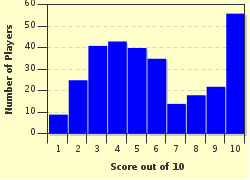Quiz Answer Key and Fun Facts
1. The story of King Leonidas and his 300 Spartans facing the massive Persian army has been well popularised by the film "300". What was the battle in which King Leonidas led his army with the belief that they were saving the lives of many other Greeks?
2. This man can be described as one of the first Christian martyrs. Along with Paul (later Saint Paul) this man set out to preach the message that gentiles should not have to conform to the stricter Jewish laws. He was later stoned to death in Salamis, Cyprus. Who was this man?
3. Rather than just following orders, there are some men who enter battle and are willing to die for their beliefs. One such man is William Wallace, who fought for Scottish independence from England in battles such as Stirling Bridge. Which English monarch ruled during this battle?
4. Which blind woman, born in 1534, refused to denounce her Protestant views and so was burnt to death at the age of 22?
5. Following the accession of Louis XIV of France to the throne there were widespread persecutions of Protestants. Some were made to serve extreme jail sentences for minor crimes whilst others were brutally forced to change their religion. There were some who refused to become Catholic and so gave up their lives for their religious beliefs instead. The revocation of which legislation in 1685 was the main cause of these persecutions?
6. The Easter Rising of 1916 aimed to end the British rule over Ireland. One of the main leaders, Patrick Pearse, saw this as a "blood sacrifice", showing that he knew that he would have to die for his beliefs. Which of these was the other leader of the Easter Rising?
7. Mohandas Karamchand Gandhi's views on violence made him famous and with this fame came a huge danger to his safety. He continued to display his beliefs, knowing that there were some who wanted him dead. How many known assassination attempts were made on Gandhi's life?
8. In the early 20th century woman began to demand the vote in the UK in more radical ways. Which woman famously "threw herself in front of the King's horse" in 1913 whilst campaigning for woman's suffrage?
9. Believing blood to be the essence of life, Jehovah's Witnesses have been known to choose death rather than have a blood transfusion. Which man founded the Bible Student movement (the group from which the Jehovah's witnesses grew from)?
10. In July 1998, 10 statues at Westminster Abbey commemorating 20th century "martyrs" were unveiled. Which of these famous people, who died for their beliefs, cannot be found at this memorial?
Source: Author
doublemm
This quiz was reviewed by FunTrivia editor
Snowman before going online.
Any errors found in FunTrivia content are routinely corrected through our feedback system.

